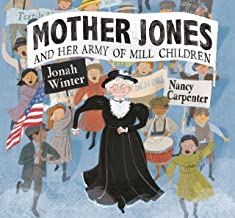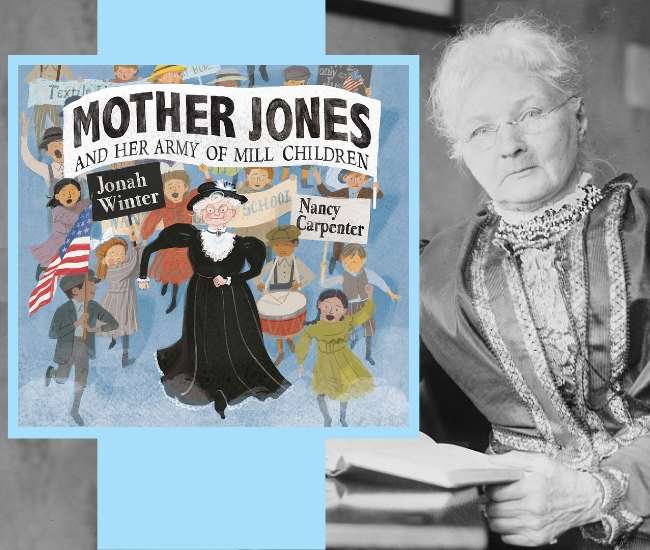Mother Jones and Her Army of Mill Children by Jonah Winter
So begins Mother Jones and Her Army of Mill Children (Random House Children’s Books), a picture book for children aged 4 to 8 written by Jonah Winter. It’s the story of the Children’s Crusade told from the perspective of the formidable Mother Jones, an activist who in her time was labeled “the most dangerous woman in America.”
Jones championed the cause of exploited workers at a time when many of our labor laws either didn’t exist or weren’t well-enforced. But it wasn’t her outspokenness that made her particularly dangerous. Certainly not her physical presence — a white-haired, grandmotherly figure well into her 60s. What drove such notoriety was her triple-threat ability to rabble-rouse others to join her cause, organize their ire into activist efforts, and, perhaps most astoundingly, attract high levels of public attention through dazzling PR stunts and spectacles.
MARCH OF THE MILL CHILDREN
The Children’s Crusade was one such effort. Organized by Jones during the summer of 1903 after failed attempts to get media coverage on the plight of child workers, the Crusade was a march that led more than 100 laborers — mostly children — from the mines, mills and factories in and around Philadelphia to the door of then-President Theodore Roosevelt’s home on Long Island.
In every town along the march’s route, Jones drew crowds of curious onlookers, which, in turn, drew the press, broadcasting the effort far and wide. She combined placards, soapbox speeches, theater performances and stunts (such as presenting children in cages to represent their employment conditions) to drive the message home that child labor is an injustice.
The story is illustrated by Nancy Carpenter, who brings the coal-powered era to life in a visceral way, particularly in the book’s opening pages. The factories in which the children work are full of dust and floating particulate matter. Indoor spaces and outdoor skies are dusky with soot and smog. These early images progress with Jones’s march into a more colorful pastel palette of street gatherings, Coney Island amusements and Roosevelt’s grand estate. The children themselves, gray and exhausted and dejected in the beginning, are soon transformed by their journey into the energetic and playful youngsters they had not until then been allowed to be.
A LEGACY THAT IMPACTS US TO THIS DAY
Child workers at the time were mostly poor and many endured abuse, injury and developmental disfigurement in the course of their often dangerous jobs. By introducing people to the actual children who labored in wretched conditions to create the textiles and other goods in their own homes, Jones’s efforts sparked a change in public awareness and concern. Eventually, public opinion became powerful enough to go toe-to-toe with industry-controlled politicians and set in motion the enactment of child labor laws that we still abide by today.
However, as Winter points out in his Author’s Note, this legacy sadly doesn’t extend beyond our borders: “There are still countries where children work in factories, some of which produce American goods. Worldwide, there are 215 million child workers. And even here and now in America, there are adults who want to reverse child labor laws. We need Mother Jones.”
We can only follow in her footsteps. She is a role model for young and old alike, and a particularly appropriate icon to celebrate during Women’s History Month. In the words of Jones, “No matter what your fight, don’t be ladylike!” Wise advice for women everywhere, including those who continue to champion labor reform across today’s global economy.






